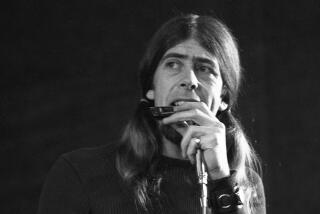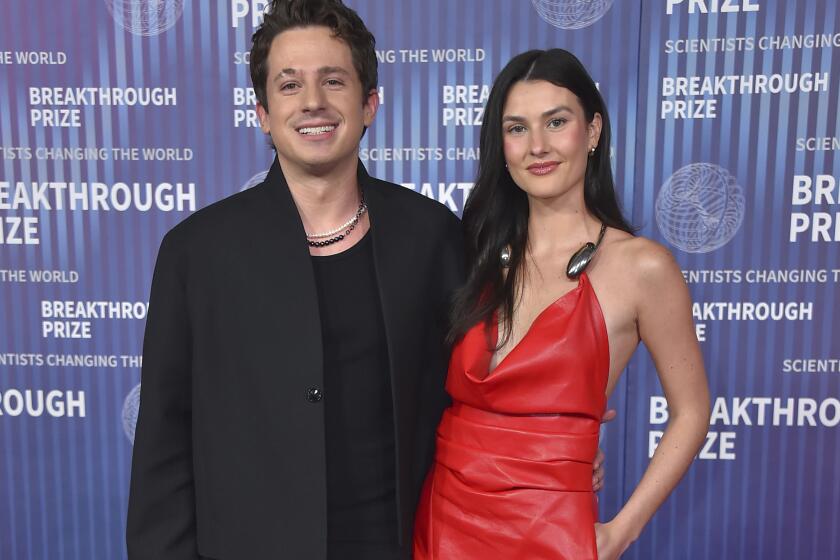JAZZ : The Superior Fusion of Creed Taylor
For some years now, the jazz world has been partitioned into at least three disparate, coexisting camps. One of these, New Age music--with its quasi-classical, often romantic overtones--is barely recognizable as a jazz-related form and now has its own separate category in the Grammy Awards voting.
Fusion is another matter. Often during the last decade, certain artists have been flitting back and forth between the areas of so-called traditional, or unhyphenated jazz (now granted its own best-seller listings in Billboard), and the more commercially oriented forms generally lumped together under the fusion banner. Herbie Hancock, Chick Corea and Freddie Hubbard are among the many who have lived multiple lives, succeeding in each area.
But what exactly is fusion? There is a tendency among some purists to deal collectively with all such music and dismiss it as artistically valueless. This is at best a half-truth. Much fusion makes extensive use of electronic instruments, of pre-set rhythm patterns and of improvisation that is often fairly limited in creativity and, in the more traditional sense, swing. The compositions and arrangements too sometimes are contrived and unimaginative.
This, of course, is a generalization. Fusion jazz can be produced and executed with good taste, in such a way that the results neither compromise the performers unreasonably nor limit the sales potential. Possibly the outstanding examples of superior fusion were those produced under the guidance of Creed Taylor.
A man of unique vision, with an ear for great talent as well as for good sound quality, Taylor was first prominent as a producer for Verve from 1962 to 1967. After a couple of years at A&M; Records, he launched his own company, Creed Taylor Inc. (generally known as CTI).
The life of CTI corresponded almost exactly with the decade of the ‘70s. Regrettably, Taylor has spent much of his time since then embroiled in legal entanglements, one of which involves a suit against Warner Bros. Records concerning the services of George Benson, who left CTI to sign with Warners. Whatever the rights and wrongs of this case, what Taylor achieved during the CTI years is not now a matter for reminiscence but a living fact. Since last spring, many of his best works have become available again, the rights having been acquired by CBS.
A new batch received recently offers illuminating testimony that fusion in many instances could achieve a healthy measure of validity. True, it didn’t always work; strings on a Milt Jackson album were a bit too saccharine, and the attempts to use classical compositions were at times debatable. Still, Taylor had more hits than misses, and a majority of his artists benefited from the treatment he accorded them.
It is particularly interesting to compare the contents of these 1970s products with the groups that currently dominate “Contemporary Jazz” (a euphemism for fusion) according to the trade papers. Reflecting on the work of Spyro Gyra, Hiroshima, Fattburger, Kenny G and the like, one wonders: Couldn’t Taylor have come up with something just as viable commercially yet more durable musically?
In most instances, there are on these CD reissues of the CTI material additional tunes, or extra masters of the same numbers, that were discovered in the vaults. As the discs reveal too an important aspect of Taylor’s creed was: When possible, cross-pollinate. Artists who appear as leaders on one album (Hubbard, Paul Desmond, Ron Carter) can be found as sidemen on others.
The following are valuable examples from the latest group:
“FIRE INTO MUSIC, Vol. II.” This compilation, the second in a series (another is due out shortly), includes one cut apiece from a dozen newly reissued sets. These include Stanley Turrentine’s “Sugar,” which still sounds engaging after 17 years, Hubbard’s in “Red Clay,” and Ron Carter’s brilliant flamenco-flavored “Spanish Blue.”
Taylor seemed to have particularly good luck (or good judgment) in the use of guitarists. In addition to Benson, the artists heard here include Jim Hall, Joe Beck and Kenny Burrell, whose “God Bless the Child” (reviewed separately below) was his only CTI album. The other fire-breathers are Hank Crawford, Jackson, Desmond and Chet Baker. 5 stars.
“GOD BLESS THE CHILD.” Kenny Burrell. CBS ZK 40808. Burrell’s gentle, often chord-rich guitar is superbly set off here with a background of five cellos, using impressionistic arrangements by Don Sebesky. Here and there are extra touches by Hubert Laws’ flute and Hubbard’s trumpet. The program begins with three Burrell originals. “A Child Is Born” was the cut excerpted for use in the “Fire Into Music” sampler. The two previously unreleased tunes are Tommy Wolf’s “Ballad of the Sad Young Men” and Kurt Weill’s “Lost in the Stars,” both performed as unaccompanied solos and doing ample justice to two superb melodies. It is debatable whether this was fusion or simply an uncompromising attempt to make Burrell’s talent accessible to a broader audience. Either way, this was a 5-star production.
“SUGAR.” Stanley Turrentine. CBS ZK 40811. Along with the title cut, this includes three long pieces: John Coltrane’s “Impressions,” in a 14-minute workout that never lets up; “Sunshine Alley” by Butch Cornell, who played organ on the session, and “Gibraltar” by Hubbard, who shared the front line with Turrentine’s boldly emotional tenor sax. The last number was never released in this version, though Turrentine recorded it later with a different group. Benson and Carter fortify this impassioned band, along with electric keyboard, drums and congas. Performances like these put Turrentine in the forefront of high-quality pop-flavored jazz. 4 stars.
“BEYOND THE BLUE HORIZON.” George Benson. CBS ZK 40809. This was Benson’s last session with a small jazz group before he broke into more pop-directed formats and began to gain a reputation as a singer. Backed by Carter on bass, Jack DeJohnette on drums, Clarence Palmer on organ and two extra percussionists, he glides elegantly through Luis Bonfa’s “The Gentle Rain,” Miles Davis’ “So What” and four of his own compositions, one of which (“All Clear”) is heard in an additional, hitherto unissued version. 4 stars. (Note: Benson’s celebrated “White Rabbit” album, with a large brass, woodwinds and rhythm ensemble arranged by Sebesky, is available on ZK 40685.)
Other artists heard to advantage on the CBS-CTI compact discs are Gerry Mulligan, Joe Farrell, Esther Phillips, Jackie & Roy, Deodato and Airto.
More to Read
The biggest entertainment stories
Get our big stories about Hollywood, film, television, music, arts, culture and more right in your inbox as soon as they publish.
You may occasionally receive promotional content from the Los Angeles Times.










